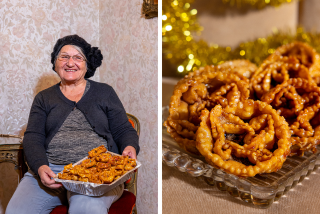Playing With Your Food
- Share via
Home-made Christmas ornaments are sort of like anchovies: Nobody is neutral on the subject, and the weight of opinion tends toward the negative. Self-sacrificing years of garish paper chains and salt clay objects only a mother could love have made a lot of people glad to call it quits once the kids are out of primary school.
All wrong. When the kids are older is when the fun starts. Their clay ornaments turn terrific when the clay is replaced by ornamental gingerbread, and the exercise easily keeps them occupied for hours.
Adults are a different story--most grown-ups would rather decorate than sculpt, and they’re not as patient about it as kids. So our annual gingerbread party includes pre-baked cookie disks, decorating bags filed with icing and an assortment of suitable decor, all set out on a big table where everyone has elbow room.
Kids play with the clay. Grown-ups make the disks into personalized Christmas balls, and everybody’s contribution gets strung onto the tree, pretty as ever you please among the other ornaments, and the fragrance is wonderful. There are many commercial potpourris that claim to evoke the aroma of a good-sized balsam fir with plenty of gingerbread decorations, but none of them come anywhere close to the real thing.
The key is to stay unintimidated; artistic ability is optional. My friend Chris, an architect, draws detailed icing cathedrals, while I consider myself doing well when I manage to write my name straight. But with the help of paper transfers, even the clumsiest can make decorations that look like a dream of Victorian Christmas come to life.
There is also life after Christmas, since this dough can be used to make Valentines, or, if it comes to that, Easter bunnies. Tightly wrapped and frozen, it keeps more or less forever.
I have given this recipe before and probably will again, since it is unexcelled. The dough is quickly made and easy to work with; the cookies extremely durable once baked. (I’m still cherishing a few dated 1988.) They’re perfectly edible, containing no weird chemicals, stabilizers or shellac, but they smell a lot better than they taste, and if you want to crunch a thick one you’d better have tough teeth. Note: If you’re making gingerbread to last, use shortening, rather than butter.
ORNAMENTAL GINGERBREAD
7 to 9 cups flour
1 tablespoon plus 2 teaspoons ground ginger
1 tablespoon ground cinnamon
2 teaspoons ground mace
2 teaspoons ground cloves
1 teaspoon baking soda
1 teaspoon salt
1 teaspoon ground cardamom
1 2/3 cups solid shortening or 2 cups butter
2 1/4 cups cups molasses
1 cup granulated sugar
1 cup dark brown sugar, packed
Combine 5 cups flour with ginger, cinnamon, mace, cloves, soda, salt and cardamom in bowl. Whisk to blend.
Combine shortening, molasses and granulated and brown sugars in large, heavy kettle. Place over medium-low heat. Cook, stirring, just until fat has melted and mixture is smooth. (Do not allow to simmer or finished dough will be dry and tough.)
Remove from heat, stir in spiced flour and let mixture cool until barely tepid. Slowly stir in additional flour until dough is smooth, soft and slightly greasy and does not stick to hands. (Be sparing with flour. Dough will stiffen as it cools.) Allow dough to cool to room temperature before use and keep tightly wrapped in plastic wrap to avoid drying out.
Makes approximately 5 pounds dough, enough for at least 60 large Christmas Ball Cookies, a family’s worth of assorted sculptures or several cookies for each holiday in year.
Cookie Sculptures: Should not be more than 1/2-inch thick, and thickness should be fairly even because little pointy parts tend to burn. Build sculptures right on parchment, always moisten 2 parts to be joined and don’t forget to leave 1 to 2 places to punch holes in for attaching thread for hanging. Bake thick pieces at 325 degrees about 25 minutes, thin pieces as below:
Christmas Ball Cookies (or other flat, cut-out): Roll dough scant 1/4-inch thick between sheets of wax paper. Peel off 1 sheet, reverse dough onto baking parchment paper and remove other sheet. Use coffee can for large round disks, whatever other cutters you like. Remove and re-roll excess dough. Slide parchment paper onto baking sheets and bake at 350 degrees about 14 minutes or until color has changed slightly and surface looks dry.
While cookies are still warm and soft, use matchstick to make hole for string. Remember to keep hole at least 1/3 inch in from edge of cookie. Cool on racks and decorate with Iron Icing.
Decorative Embellishments: Raisins, red hots, colored sugars and silver and gold dragees are most common, but don’t forget whole cloves, whole star anise, dried rosebuds and lavender flowers (available at some florists and hobby stores, if you forgot to dry your own last summer). Pictures to paste onto icing can be cut from magazines or wrapping paper, but easiest to use are paper stickers. Dover Books, for instance, publishes 3 different booklets of reproductions of “Yuletide Victorians,” each $3.50.
Iron Icing: Beat 1 egg white until loosened, then stir in powdered sugar until icing is achieved. Mixture will be lumpy at first, then smooth out. Keep on flow-y side to coat cookies with even sheet of white. Continue to add sugar until lifted spoon leaves thin trail on top of mass if you want decorating icing that won’t sag or run.
Plastic sandwich bags are ideal decorating bags, inexpensive and disposable. Use kind with square corners and don’t fill more than 1/3 full. Snip tiny triangle from one corner, twist top of bag securely and squeeze out line of icing with which to draw, write, squiggle or dot as Christmas spirit moves you.
More to Read
Eat your way across L.A.
Get our weekly Tasting Notes newsletter for reviews, news and more.
You may occasionally receive promotional content from the Los Angeles Times.










